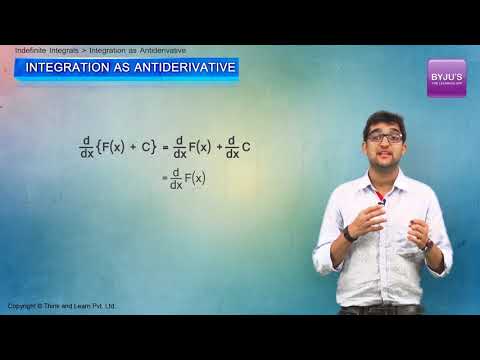We will be exploring some of the important properties of definite integrals and their proofs in this article to get a better understanding. Integration is the estimation of an integral. It is just the opposite process of differentiation. Integrals in maths are used to find many useful quantities such as areas, volumes, displacement, etc. There are two types of Integrals namely, definite integral and indefinite integral. Here, we will learn the different properties of definite integrals, which will help to solve integration problems based on them.
Table of Contents:
Definite Integral Definition
If an integral has upper and lower limits, it is called a Definite Integral. There are many definite integral formulas and properties. Definite Integral is the difference between the values of the integral at the specified upper and lower limit of the independent variable. It is represented as;
∫ab f(x) dx
Definite Integrals Properties
Following is the list of important properties of definite integrals which is easy to read and understand.
|
Properties |
Description |
|
Property 1 |
p∫q f(a) da = p∫q f(t) dt |
| Property 2 | p∫q f(a) d(a) = – q∫p f(a) d(a), Also p∫p f(a) d(a) = 0 |
| Property 3 | p∫q f(a) d(a) = p∫r f(a) d(a) + r∫q f(a) d(a), where p < r < q |
| Property 4 | p∫q f(a) d(a) = p∫q f( p + q – a) d(a) |
| Property 5 | o∫p f(a) d(a) = o∫p f(p – a) d(a) |
| Property 6 | ∫02p f(a)da = ∫0p f(a)da +∫0p f(2p-a)da…if f(2p-a) = f(a) |
| Property 7 | 2 parts
|
| Property 8 | 2 parts
|
Properties of Definite Integrals Proofs
Property 1: p∫q f(a) da = p∫q f(t) dt
This is the simplest property as only a is to be substituted by t, and the desired result is obtained.
Property 2: p∫q f(a) d(a) = – q∫p f(a) d(a), Also p∫p f(a) d(a) = 0
Suppose I = p∫q f(a) d(a)
If f’ is the anti-derivative of f, then use the second fundamental theorem of calculus, to get I = f’(q)-f’(p) = – [f’(p) – f’(q)] = – q∫p(a)da. Also, if p = q, then I= f’(q)-f’(p) = f’(p) -f’(p) = 0. Hence, a∫af(a)da = 0.
Property 3: p∫q f(a) d(a) = p∫r f(a) d(a) + r∫q f(a) d(a)
If f’ is the anti-derivative of f, then use the second fundamental theorem of calculus, to get;
p∫q f(a)da = f’(q)-f’(p)… (1)
p∫rf(a)da = f’(r) – f’(p)… (2)
r∫qf(a)da = f’(q) – f’(r) … (3)
Let’s add equations (2) and (3), to get
p∫r f(a)daf(a)da + r∫q f(a)daf(a)da = f’(r) – f’(p) + f’(q)
= f’(q) – f’(p) = p∫q f(a)da
Property 4: p∫q f(a) d(a) = p∫q f( p + q – a) d(a)
Let, t = (p+q-a), or a = (p+q – t), so that dt = – da … (4)
Also, note that when a = p, t = q and when a = q, t = p. So, p∫q wil be replaced by q∫p when we replace a by t. Therefore,
p∫q f(a)da = –q∫p f(p+q-t)dt … from equation (4)
From property 2, we know that p∫q f(a)da = – q∫p f(a)da. Use this property, to get
p∫q f(a)da =p∫q f(p+q-t)dt
Now use property 1 to get
p∫q f(a)da = p∫q f(p + q – a )da
Let, t = (p-a) or a = (p – t), so that dt = – da …(5)
Also, observe that when a = 0, t =p and when a = p, t = 0.
Therefore,
From Property 2, we know that
Using this property , we get
Next, using Property 1, we get
From property 3, we know that
Therefore,
Where,
Let, t = (2p – a) or a = (2p – t), so that dt = -da …(7)
Also, note that when a = p, t = p, and when a =2p, t= 0.
Hence, when we replace a by t,
Therefore,
From Property 2, we know that
Using this property, we get
Next, using Property 1, we get
Replacing the value of I2 in equation (6), we get
we know that
Now, if f(2p – a) = f(a), then equation (8) becomes
And, if f(2p – a) = – f(a), then equation (8) becomes
Using Property 3, we have
Where,
Consider I1
Let, t = -a or a = -t, so that dt = -da … (10)
Also, observe that when a = -p, t = p, when a = 0, t =0.
Therefore,
From Property 2, we know that
Use this property to get,
Next, using Property 1, we get
Replacing the value of I2 in equation (9), we get
Now, if ‘f’ is an even function, then f(– a) = f(a). Therefore, equation (11) becomes
And, if ‘f’ is an odd function, then f(–a) = – f(a). Therefore, equation (11) becomes
Now, let us evaluate Definite Integral through a problem sum.
Example on Properties of Definite Integrals
Example 1:
Prove that 0∫π/2 (2log sinx – log sin 2x)dx = – (π/2) log 2 using the properties of definite integral
Solution:
To prove: 0∫π/2 (2log sinx – log sin 2x)dx = – (π/2) log 2
Proof:
Let take I = 0∫π/2 (2log sinx – log sin 2x)dx …(1)
By using the property of definite integral
0∫a f(x) dx = 0∫a f(a-x) dx
Now, apply the property in (1), we get
I = 0∫π/2 2log sin[(π/2)-x] – log sin 2[(π/2)-x])dx
The above expression can be written as
I = 0∫π/2 [2log cosx- log sin(π-2x)]dx (Since, sin (90-θ = cos θ)
I = 0∫π/2 [2log cosx- log sin2x]dx ..(2)
Now, add the equation (1) and (2), we get
I+ I = 0∫π/2 [(2log sinx – log sin 2x) +(2log cosx- log sin2x)]dx
2I = 0∫π/2 [2log sinx -2log 2sinx + 2log cos x]dx
2I = 2 0∫π/2 [log sinx -log 2sinx + log cos x]dx
Now, cancel out 2 on both the sides, we get
I = 0∫π/2 [log sinx + log cos x- log 2sinx]dx
Now, apply the logarithm property, we get
I = 0∫π/2log[(sinx. cos x)/sin2x]dx
We know that sin2x= 2 sinx cos x)
Now, the integral expression can be written as
I = 0∫π/2log[(sinx. cos x)/(2 sinx cos x)]dx
Cancel the terms which are common in both numerator and denominator, then we get
I = 0∫π/2 log(1/2)dx
It can be written as
I = 0∫π/2 (log1-log 2)dx [Since, log (a/b) = log a- log b]
I = 0∫π/2 -log 2 dx (value of log 1 = 0)
Now, take the constant – log 2 outside the integral,
I = -log 2 0∫π/2dx
Now, integrate the function
I = -log 2 [x]0π/2
Now, substitute the limits
I = -log 2 [(π/2)-0]
I = – log 2 (π/2)
I = – (π/2) log 2 = R.H.S
Therefore, L.H. S = R.H.S
Hence. 0∫π/2 (2log sinx – log sin 2x)dx = – (π/2) log 2 is proved.
Integration vs Anti-derivative

Properties of Definite Integration for JEE Part 1

Frequently Asked Questions on Properties of Definite Integral
Define definite integral
The definite integral is defined as an integral with two specified limits called the upper and the lower limit. The definite integral of a function generally represents the area under the curve from the lower bound value to the higher bound value.
What are the different properties of definite integral?
Some of the important properties of definite integrals are:
Adding Function Property
Adding intervals property
Interval of zero-length property
Reversing the interval property
The area above – area below property
What is the difference between the definite integral and the indefinite integral?
The definite integral f(x) is a number that defines the area under the curves within the specified limits. It has an upper limit and lower limit and it gives a definite answer. Whereas the indefinite integral f(x) is a function and it has no upper and lower limits. It gives a solution to the question “what function produces f(x) when it is differentiated?”.
Mention the four important concepts covered in calculus?
The most important basic concepts in calculus are:
Function
Limits
Integral
Derivatives
Define the definite integral of a function?
The definite integral of a function on the interval [a, b] is defined as the difference of antiderivative of the given function, which is calculated for the upper bound of integration minus the lower bound of integration.
Subscribe to BYJU’S to watch an explanatory video on Definite Integral and many more Mathematical topics.
Comments